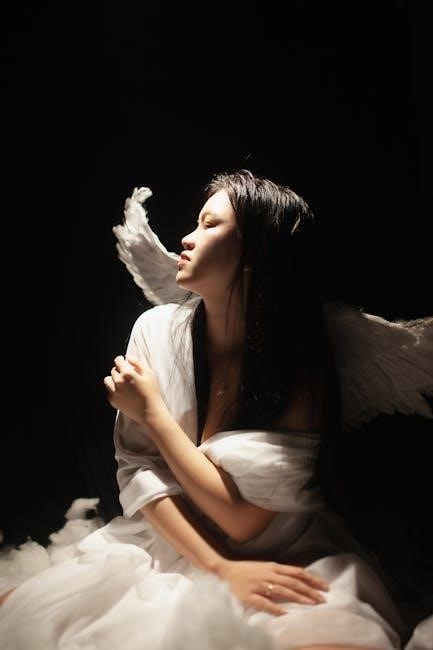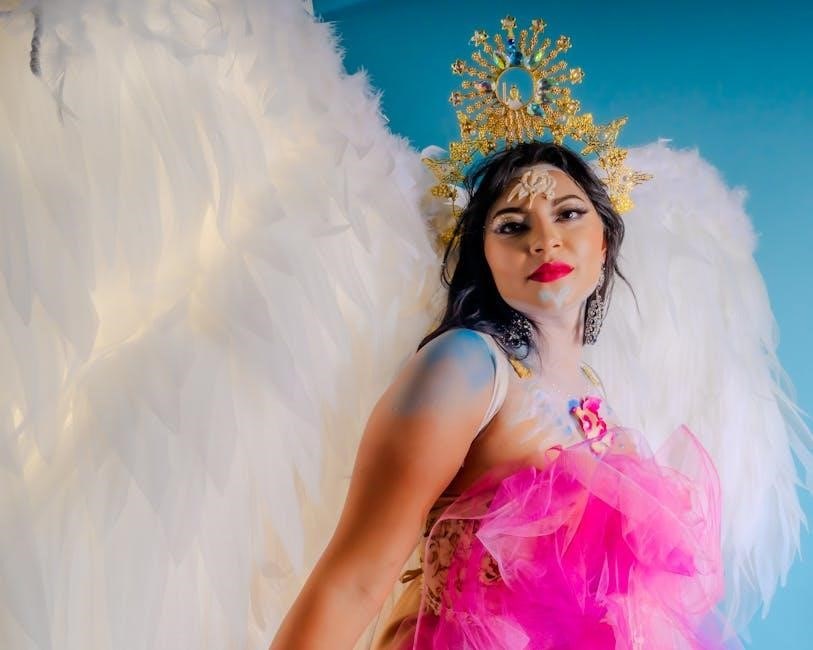Angel wings symbolize divine guidance, protection, and transcendence, often depicted in art, religion, and culture. Their beauty and significance inspire creativity, comfort, and spiritual connection globally.
What Are Angel Wings?
Angel wings are symbolic representations often depicted as feathered appendages, commonly associated with celestial beings like angels. They are frequently portrayed in art, literature, and religion as a sign of divine presence, protection, and grace. In many cultures, angel wings embody purity, hope, and transcendence, serving as a visual metaphor for spirituality. Their depiction varies across mediums, from intricate details in religious paintings to abstract designs in modern art. Beyond their spiritual significance, angel wings have become a popular motif in fashion, jewelry, and even tattoos, symbolizing personal beliefs, comfort, or transformation. Their universal appeal lies in their ability to evoke emotions of peace and connection to something greater.
The Symbolism Behind Angel Wings
Angel wings carry profound symbolic meanings, often representing divine protection, spiritual guidance, and eternal hope. They are universally recognized as a metaphor for transcendence and connection to the divine. In religious contexts, wings signify the ability to rise above earthly concerns and reach heavenly realms. They also embody innocence, purity, and the soul’s journey toward enlightenment. Beyond religion, angel wings symbolize comfort, resilience, and personal transformation. Their presence in art and culture serves as a reminder of celestial guardianship and the enduring human quest for meaning and solace. The imagery of wings transcends boundaries, offering a powerful visual language that resonates deeply across cultures and belief systems.
Cultural and Religious Significance
Angel wings hold profound cultural and religious meaning, symbolizing divine messenger roles in Christianity, Islam, and Judaism. They represent protection, grace, and spiritual guidance across faiths and traditions.
Angel Wings in Christianity
In Christianity, angel wings are a powerful symbol of divine presence and messengers of God. Often depicted as winged beings, angels like cherubim and seraphim are central to religious art and scripture. They represent protection, guidance, and God’s love. The Bible describes angels with wings as harbingers of significant events, such as the Annunciation. Their imagery in churches and literature reinforces their role as intermediaries between heaven and earth. The winged form emphasizes their celestial nature, inspiring devotion and comforting believers in times of need, while also symbolizing swiftness in fulfilling divine will. This imagery remains a cornerstone of Christian faith and artistry.
Angel Wings in Other Religions and Cultures
Angel wings appear in various religious and cultural contexts beyond Christianity, symbolizing divine messengers, protection, and spiritual transcendence. In Islam, angels like Jibril (Gabriel) are often depicted with wings, representing God’s intermediaries. Hinduism features winged deities such as Garuda, who embody strength and divine transport. Ancient mythologies, like Egyptian and Greek, include winged beings like Horus and Nike, symbolizing divine favor and victory. Across cultures, wings signify freedom, guidance, and connection to the divine. These symbols inspire art, comfort, and spiritual reflection, bridging earthly and heavenly realms. Their universal presence reflects humanity’s deep desire to connect with the transcendent and the unknown.
Historical Perspectives
Angel wings have ancient roots, appearing in Mesopotamian and Egyptian art as symbols of divine power. Early Christian art popularized winged angels, evolving into detailed Renaissance depictions.
The Origins of Angel Wings in Art and Literature
Angel wings first appeared in ancient Mesopotamian and Egyptian art, symbolizing divine power and transcendence. In early Christian imagery, they were used to depict celestial beings, with detailed feathered designs becoming prominent during the Renaissance. Literature often linked wings to divine messengers, emphasizing their role in bridging the earthly and heavenly realms. Over time, these depictions evolved, reflecting cultural and religious influences while maintaining their universal significance as symbols of hope and divine guidance. This rich history continues to inspire artistic and literary interpretations today.
Evolution of Angel Wing Depictions Over Time
The depiction of angel wings has transformed significantly across centuries, reflecting cultural and artistic trends. Early representations in Mesopotamian and Egyptian art often featured stylized, symbolic wings, while early Christian art emphasized their divine nature with simpler designs. The Renaissance brought intricate feathered details, influenced by humanism and realism. By the Victorian era, wings became more flowing and ethereal, symbolizing mourning and spirituality. Modern art has diversified these depictions, with abstract and minimalist interpretations emerging alongside traditional forms. Digital art and 3D modeling have further expanded creative possibilities, blending traditional symbolism with contemporary aesthetics. This evolution highlights the enduring yet adaptable nature of angel wings as a cultural and artistic motif.
Psychological and Emotional Impact
Angel wings symbolize comfort and protection, offering solace during grief. They embody hope and reassurance, providing a spiritual connection that helps individuals cope with emotional pain and loss.
Angel Wings as a Symbol of Protection and Comfort

Angel wings are universally recognized as a symbol of divine protection and comfort, offering solace in times of distress. Their depiction in religious art and literature often conveys safeguarding and support, providing a sense of spiritual security. Many cultures associate angel wings with guardianship, believing they shield individuals from harm. This imagery resonates deeply, offering emotional reassurance and hope during challenging moments. The presence of angel wings, whether in personal experiences or art, serves as a reminder of divine care and enduring protection. Their enduring appeal lies in their ability to evoke feelings of safety and unconditional support.
The Role of Angel Wings in Grief and Mourning
Angel wings often serve as a comforting symbol during periods of grief and mourning, providing emotional solace and a sense of connection to the deceased. They are frequently depicted in memorials, funeral art, and condolence messages, representing a bridge between the earthly and divine realms. Many find comfort in the belief that angel wings carry the spirits of loved ones to peace, offering reassurance of their safe passage. This imagery helps individuals process loss, fostering a sense of hope and healing. Angel wings also appear in personal rituals, such as wearing wing-shaped jewelry or displaying wing-inspired art, as a way to honor and remember those who have passed. Their presence provides enduring emotional support during difficult times.

Practical Applications

Angel wings inspire creativity in fashion, jewelry, and art, offering tutorials and guides for crafting wing designs, while PDF resources provide step-by-step instructions for enthusiasts.
How to Draw Angel Wings: A Step-by-Step Guide
Drawing angel wings can be a creative and fulfilling experience. Start by sketching the basic shape, ensuring symmetry and balance. Begin with a central feather, then gradually add more feathers around it, varying their sizes and angles for a natural look. Pay attention to detail, adding texture to the feathers for realism. Use reference images to guide your proportions and shading techniques. Practice layering strokes to create depth and dimension. Avoid overcomplicating the design initially; start simple and refine as you progress. Consider using a PDF guide for precise templates and tutorials. Remember, patience and practice are key to mastering this divine art form.
Angel Wings in Fashion and Jewelry
Angel wings have become a popular motif in fashion and jewelry, symbolizing protection, grace, and spirituality. Designers incorporate winged elements into clothing, accessories, and ornaments, often using delicate patterns or bold statements. Jewelry pieces, such as pendants and earrings, feature intricate wing designs, appealing to those seeking meaningful adornments; Fashion collections often include wing-inspired details, from subtle embroidery to dramatic silhouettes. This trend reflects a desire for wearable art that carries emotional and symbolic significance. The use of angel wings in fashion and jewelry continues to evolve, blending tradition with contemporary style, making it a timeless and universal choice for expressing individuality and faith.

Angel Wings in Popular Culture
Angel wings inspire characters and narratives in movies, TV shows, and music. They symbolize protection, grace, and divine connection, resonating emotionally with audiences worldwide through various creative expressions.
Angel Wings in Movies and Television
Angel wings have captivated audiences in films and TV shows, often symbolizing divine intervention, protection, and transcendence. From movies like It’s a Wonderful Life to series like Supernatural, angelic imagery evokes emotional resonance. In Maximum Ride, based on James Patterson’s books, winged characters embody both strength and vulnerability. These depictions inspire reflection on spirituality and human connection. The portrayal of angel wings in popular media continues to evolve, blending traditional symbolism with modern storytelling, ensuring their enduring appeal across genres and generations. Their presence in visual narratives serves as a reminder of hope, guidance, and the timeless allure of the divine.
Angel Wings in Music and Lyrics
Angel wings are a timeless and universal metaphor in music, symbolizing divine guidance, protection, and eternal hope. Across genres, artists have used winged imagery to convey emotional and spiritual journeys. From classic hymns to contemporary ballads, the theme of angel wings resonates deeply, often reflecting themes of loss, comfort, and transcendence. In Jimmy’s lyrics, for example, storytelling weaves fictional and factual narratives, creating a poetic connection to the divine. Musicians often draw on angelic imagery to explore human experiences, making their songs relatable and emotionally powerful. This enduring motif continues to inspire creators, offering solace and inspiration to listeners worldwide. A PDF guide to angel wing designs further highlights their artistic appeal.

Angel Wings in Art
Angel wings have been a timeless subject in art, symbolizing divine beauty and spirituality. From classical paintings to modern interpretations, their depiction continues to inspire and captivate audiences, blending tradition with contemporary creativity.
Famous Paintings Featuring Angel Wings
Angel wings have captivated artists for centuries, appearing in masterpieces like Michelangelo’s The Last Judgment and Raphael’s Sistine Madonna. These paintings depict wings as symbols of divine grace and spirituality, often surrounding religious figures. In The Last Judgment, angels’ wings emphasize their celestial nature, while Raphael’s work showcases their elegance and serenity. Other notable works include Rembrandt’s The Ascension and Fra Angelico’s The Annunciation, where wings convey the heavenly and the sublime. These paintings not only highlight artistic mastery but also the enduring symbolic power of angel wings in art and culture, inspiring awe and reflection across generations. Their beauty and spiritual depth continue to resonate deeply with audiences worldwide.
Modern Art Interpretations of Angel Wings
Modern artists have reimagined angel wings in diverse and innovative ways, blending traditional symbolism with contemporary themes. Many works feature abstract or fragmented wings, exploring themes of identity, freedom, and spirituality. Digital artists use vibrant colors and dynamic compositions to create ethereal, otherworldly effects. Some installations incorporate materials like metal or glass, adding texture and depth. Street artists have also embraced angel wings, painting large-scale murals that inspire hope and reflection in public spaces. These modern interpretations often depart from religious contexts, focusing instead on universal emotions and personal experiences. By pushing boundaries, modern art expands the timeless appeal of angel wings, making them relevant to new generations and cultural landscapes.
Angel Wings and Spirituality
Angel wings embody spiritual growth, offering protection and divine connection. They guide individuals toward inner peace and enlightenment, often used in meditative practices for healing and reflection.
Angel Wings as a Spiritual Symbol
Angel wings are a universal symbol of spirituality, representing divine protection, guidance, and connection to the sacred. They embody the idea of transcendence, linking the earthly realm to the heavenly. Often depicted as pure and serene, angel wings inspire feelings of comfort and solace, reminding individuals of divine presence in their lives. In spiritual practices, they are used to signify trust in a higher power and the journey toward enlightenment. Many believe that angel wings carry prayers to the heavens, serving as a bridge between the physical and spiritual worlds. Their imagery is widely used in meditation and healing practices to foster inner peace and harmony.
Angel Wings in Meditative and Healing Practices
Angel wings are a powerful tool in meditative and healing practices, offering a sense of divine protection and comfort. During meditation, visualizing angel wings can create a safe, serene environment, helping individuals connect with their inner selves. The imagery of wings often symbolizes release from burdens, promoting emotional and spiritual healing. In energy healing, angel wings are believed to channel divine light, balancing the body and soul. Practitioners use wing symbolism to guide clients toward inner peace and harmony. This practice fosters a deep sense of trust and renewal, making angel wings a cherished element in holistic wellness and spiritual growth. Their presence in meditation and healing rituals continues to inspire and uplift many on their journey toward wholeness.


Creating Your Own Angel Wings
Designing angel wings allows for personal expression and creativity. Use materials like feathers, fabric, or paper to craft unique, meaningful wing art. Experiment with shapes and textures.
DIY Angel Wing Crafts
Creating angel wings at home is a fun and creative activity. Start by tracing wing shapes on paper or fabric. Use glue to attach feathers, glitter, or beads for a decorative touch. Add a wire or string to hang your wings. For a more durable option, use cardboard or foam as the base. Paint and customize with personal symbols or colors. Attach elastic straps to wear them. For a 3D effect, layer feathers or fabric in a wing-like pattern. Share your creations as gifts or display them in your home. This craft encourages creativity and serves as a meaningful way to explore the symbolism of angel wings.
How to Create a PDF Guide for Angel Wing Designs
Creating a PDF guide for angel wing designs involves organizing your ideas and visuals. Start by outlining sections such as history, symbolism, and tutorials. Use a design tool like Canva or Adobe InDesign to layout your content. Include high-quality images of different angel wing styles, from traditional to modern interpretations. Add step-by-step tutorials for drawing or crafting wings. Incorporate inspirational quotes and cultural references to enrich the guide. Once satisfied with the design, export the document as a PDF. Share your guide online or print it for workshops or personal use. This comprehensive resource will help others explore and create their own angel wing designs with ease and creativity.
Angel wings remain a timeless symbol of hope, protection, and divine connection, inspiring art, culture, and personal reflection across generations. Their enduring appeal continues to captivate humanity universally.
The Enduring Appeal of Angel Wings
The allure of angel wings lies in their universal symbolism of hope, protection, and transcendence. Across cultures and centuries, they have inspired art, literature, and spirituality. Their depiction in religious icons, such as in Christianity, highlights divine guidance and comfort. Beyond religion, angel wings appear in fashion, jewelry, and popular culture, offering solace and beauty. They evoke a sense of purity and grace, resonating deeply with human emotions. Whether as a metaphor for spiritual upliftment or a design element, angel wings continue to captivate hearts and minds, embodying timeless themes of love and eternal connection. Their presence transcends boundaries, making them a cherished and enduring symbol.
Final Thoughts on the Significance of Angel Wings
Angel wings hold profound significance as symbols of hope, protection, and divine guidance. Their universal appeal transcends cultural and religious boundaries, offering comfort in times of grief and inspiration in art and spirituality. From their depiction in religious icons to their role in modern fashion and media, angel wings evoke a sense of purity and transcendence. They remind us of the enduring human quest for connection to something greater. Whether as a metaphor for spiritual upliftment or a design element, angel wings continue to resonate deeply, embodying themes of love, light, and eternal hope. Their presence in our lives serves as a reminder of the beauty and solace found in the divine.
